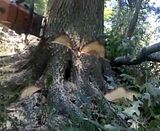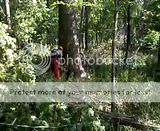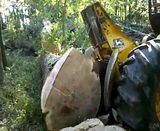You are using an out of date browser. It may not display this or other websites correctly.
You should upgrade or use an alternative browser.
You should upgrade or use an alternative browser.
Some sawing, logging and skidding pics and videos ......
- Thread starter Slamm
- Start date

Help Support Arborist Forum:
This site may earn a commission from merchant affiliate
links, including eBay, Amazon, and others.
Slamm
Addicted to ArboristSite
I got my ported, OEM P&C, 660 last night and put it to work today. Flat ground and big trees make for a fun day. It wore a 28" bar.
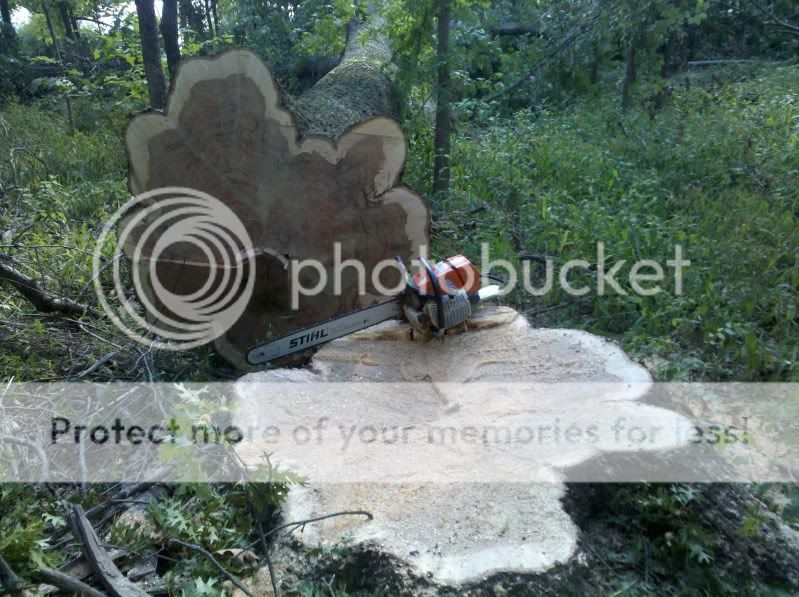
Ugly Stump there, LOL. The 28" bar could reach all but about a 1.5"-2" little square in the middle:
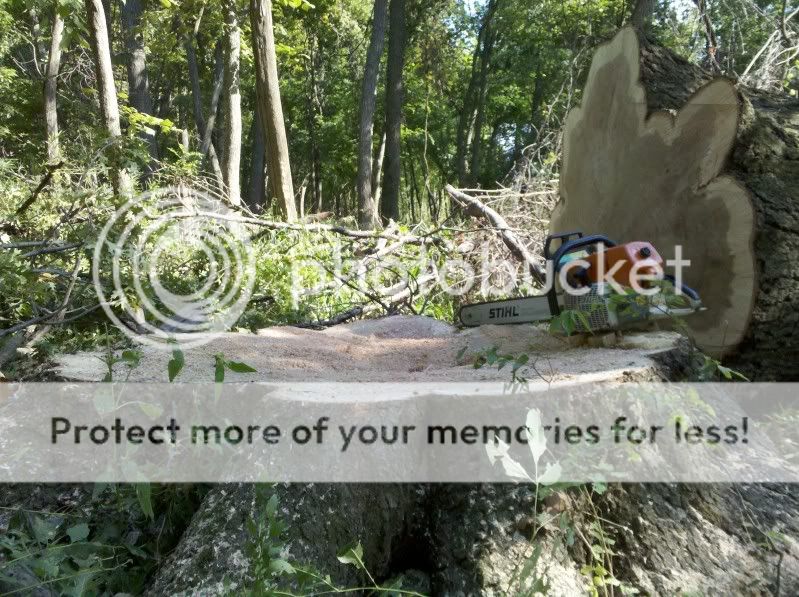
Here is the top cut:
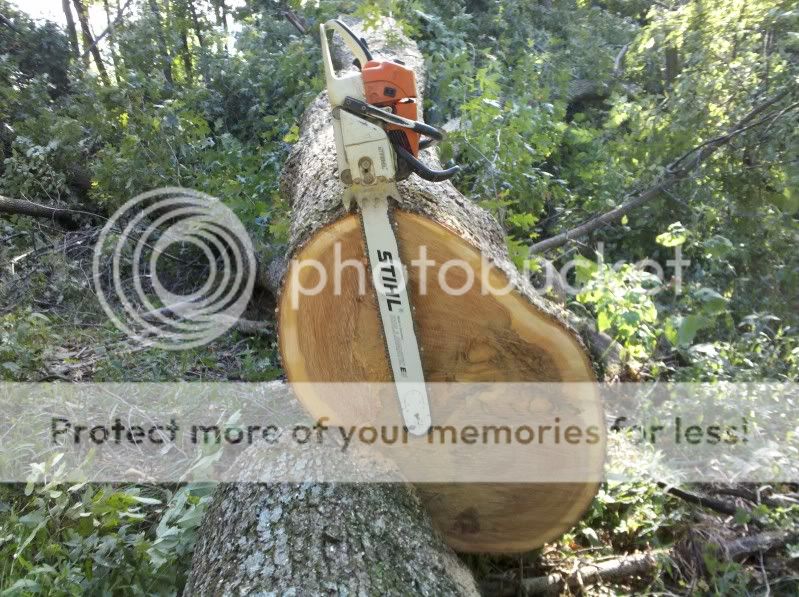
Hooking that tree up, choker wouldn't fit, thats a nice thing though, LOL. I think there was about 650 BDFT in this butt log.
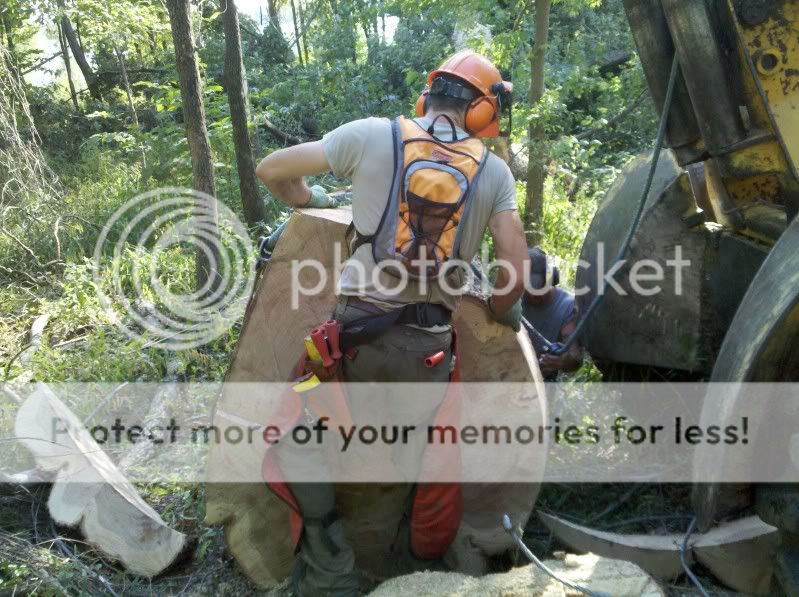
Here one of the guys are pulling out another big tree from today, this is not the same tree as above:
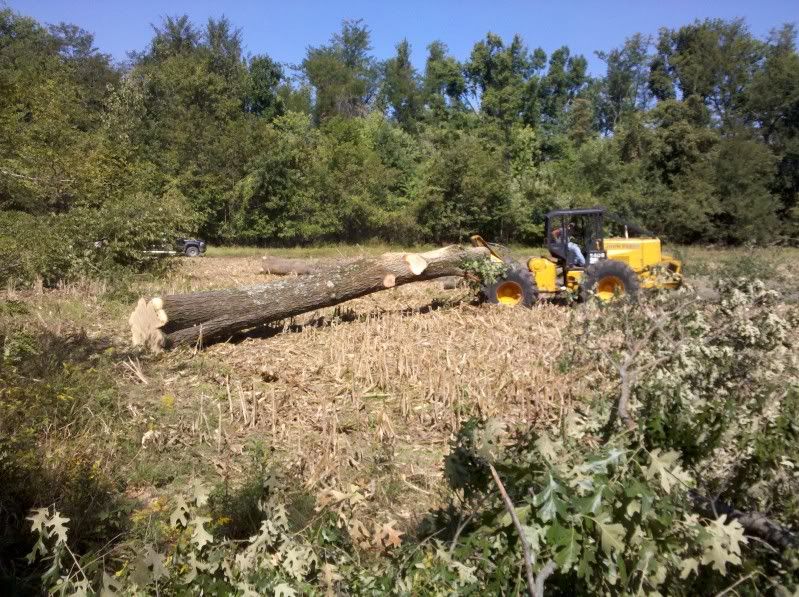
Try to get a couple of videos uploaded for later,
Sam

Ugly Stump there, LOL. The 28" bar could reach all but about a 1.5"-2" little square in the middle:

Here is the top cut:

Hooking that tree up, choker wouldn't fit, thats a nice thing though, LOL. I think there was about 650 BDFT in this butt log.

Here one of the guys are pulling out another big tree from today, this is not the same tree as above:

Try to get a couple of videos uploaded for later,
Sam
Slamm
Addicted to ArboristSite
bitzer
******** Timber Expert
Looks like fun man!
I agree with the kid though. You could be gettin a lot more wood on the ground. Don't limit yourself to faces. Depth, type, dutchman for swing cuts. Not every tree gets the same cuts and wedges have their limit (beating the hell out of them is over-rated). Every tree is different and can be cut differently. Theres a whole lot you could be doing to increase your production. 32" bar and a serious single bit for starters. Figuring out your limits on how far you can swing one or what you can do with a leaner. Cutting the compression side first. Bore on heavy headed leaners that might chair only or only when you need to. Swing through the back cut on the rest. Cut form one side, etc. Look up occasionaly! #### happens. Its it worth cuttin all the flairs off or just cutting it up a little higher? I may sound like a #### and you've got a hell of a nice set up, but I think you could really make it top notch with a few adjustments.
I agree with the kid though. You could be gettin a lot more wood on the ground. Don't limit yourself to faces. Depth, type, dutchman for swing cuts. Not every tree gets the same cuts and wedges have their limit (beating the hell out of them is over-rated). Every tree is different and can be cut differently. Theres a whole lot you could be doing to increase your production. 32" bar and a serious single bit for starters. Figuring out your limits on how far you can swing one or what you can do with a leaner. Cutting the compression side first. Bore on heavy headed leaners that might chair only or only when you need to. Swing through the back cut on the rest. Cut form one side, etc. Look up occasionaly! #### happens. Its it worth cuttin all the flairs off or just cutting it up a little higher? I may sound like a #### and you've got a hell of a nice set up, but I think you could really make it top notch with a few adjustments.
Last edited:
Slamm
Addicted to ArboristSite
Looks like fun man!
I agree with the kid though. You could be gettin a lot more wood on the ground. Don't limit yourself to faces. Depth, type, dutchman for swing cuts. Not every tree gets the same cuts and wedges have their limit (beating the hell out of them is over-rated). Every tree is different and can be cut differently. Theres a whole lot you could be doing to increase your production. 32" bar and a serious single bit for starters. Figuring out your limits on how far you can swing one or what you can do with a leaner. Cutting the compression side first. Bore on heavy headed leaners that might chair only or only when you need to. Swing through the back cut on the rest. Cut form one side, etc. Look up occasionaly! #### happens. Its it worth cuttin all the flairs off or just cutting it up a little higher? I may sound like a #### and you've got a hell of a nice set up, but I think you could really make it top notch with a few adjustments.
? Well what are you guys calling high production. In this timber, that has both trees of this size and then a few 19-24" trees and then 4 trees about this size. I can get 6-13 trees per hour down and topped. There are of course some that get hung and such, but easily I can maintain 8-10 trees per hour throughout a day in this style of timber. I know because I keep pretty close records. Here I am using 660's and 28" bars. That is actually my favorite setup for less steep hills and decent trees.
When I go cut, I don' start the skidder and cut three trees and pull three trees and cutt three trees and skid three trees. I go cut 30-60 trees one day and we pull them out the next day or the skidders move in days later and pull everything out, while the cutter/s go somewhere else. I don't really like cutting around skidders and I don't want the skidders bothered by me.
My personally best was a 100% Cherry tree job I bought and sold the timber in Wisconsin. I cut 98 trees in 6.5 hours. Again, these were butter soft cherry trees and they had zero branches, literally cut and top = 2 cuts. They were 20" trees +/- 4".
I don't always bore cut. I like to bore cut, but I run around some of them, use wedges on some, but only to assist in a slight increase in control or to get a little more angle out of a leaner that I want to go slightly different.
I'm sure I could cut a lot faster, but you have to understand that as the owner and direct benefactor of increased skidder production and smoothness of their operation, I don't mind sacrificing speed on my or the cutters behalf. I don't see that as important as fast skidding. I could be wrong, but skidders make $100-500 per hour, while a cutter slow, fast or super fast, $30-100. So I would like to take the time and make sure the butts are easily lined up to the logging trail or trim any knots or branches off that might hangup on a turn and break something, or cut down trees that I already know will cause the skidder to have a problem.
Is all of that slower, I might win some points, while loosing some others in the course of the whole operation, but I can say that a tract of my cut timber looks very, very clean and professional with most if not all stumps low, level and clean. I can say that in slow times of economy or timber value over the last 6 years, my machines have stayed working when I wanted/needed them to. If that is the price I pay for supposively cutting the trees a little slower, that is fine with me.
Our timber buyer calls other loggers "hack and stack" loggers and "they will not work for me", well, I guess, I fall into the "non-hack and stack" crowd. I have worked with cutters that do a lot of walking around the tree and its faster, but man they end up ripping the sides out of a lot of good white oaks and hickory, some buyers say something and some don't. When I started in Wisconsin, if you didn't bore cut, they would not hire you. They taught me to bore cut and said "To perfect that cut", and you don't or won't need much else. I agree there are about 50 different ways to cut a tree down, but bore cutting is typically safer for both cutter and the tree (if you are interested in not splitting or damaging any wood on the butt).
One of my faster ways is to swing the bar from back of the tree to the front on one side and from the front to the back on the other side. I do this in a way that I don't or rarely "over cut" or "double cut" a shelf. This in, effect will sever all fibers on the stump except for the hinge and the final back section that releases the tree, even tho, I never actually made a "bore cut", as I am always cutting with the bottom of the bar and its dawged in. This is my favorite cut with strong modded saws, because I push them with one hand and my knees and don't have to use my arms very much. (not sure if that made any sense, LOL)
I do cut my trees from one side if they are 28" and smaller, as I like to use a 28" bar, where as, around here most use a 20" and 24" bars. I like the 28" because on a lot of these sized trees you can get through a lot of the smaller averages, while staying on one side of the tree.
I wear that backpack drink holder to save time on drinking water. I typically drink when I'm making my felling cuts and sometimes when running from the stump to the top cut. With bottles and jugs you have to stop and go get it or what not. My personal favorite is, stop the skidder driver to get you a drink, LOL, thats a money maker there.
I thank you for your help, and I do consider it, and will play around with some different style of cuts in this timber as it is mostly Pin Oak and Soft Maple so the quality and value is not like the good white oak, veneer or grade hardwoods. Other than a 1 million bdft job in Iowa that was total cottonwood, this is the least valuable timber I have cut in 6 years, as it is just a good river bottom.
Thanks,
Sam
Slamm
Addicted to ArboristSite
Its it worth cuttin all the flairs off or just cutting it up a little higher?
Hey, I have tried to compromise a little on this swelled up river stuff. I came up a little, but not near as high and some other logger that logged close by, their stumps are easily 2 feet high on average some 2.5, that is just wasteful and hard on skidder blades and undercarriage, not to mention is really limits the skidder drivers options on which possible course they could take, when the different routes are full of 2.5 tall stumps. Things like that add up to more than the value of super fast cutting.
I might be wrong on this one, but I'm more for the skidder having it easy than for the cutter having it easy. Again skidders $100-500 per hour and a cutter $30-100 per hour, I don't care about the cutter near as much ............ even when its me, LOL.
Sam

$26.99 ($0.22 / Foot)
$29.99 ($0.25 / Foot)
VEVOR Double Braided Polyester Rope, 1/2 in x 120 ft, 48 Strands, 8000 LBS Breaking Strength Outdoor Rope, Arborist Rigging Rope for Rock Hiking Camping Swing Rappelling Rescue, Orange/Black
Amazon.com

$79.99
ZELARMAN Chainsaw Chaps 8-layer Protective Apron Wrap Adjustable Chainsaw Pants/Chap for Loggers Forest Workers Class A
QUALITY GARDEN & HAND TOOLS

$38.99 ($0.39 / Foot)
Arborist Rope Climbing Rope Swing for Tree(1/2in x 100ft) Logging Rope 48 Strands for Pull, Swing, Knot (Orange)
SDFJKLDI

$215.05
$233.19
Weaver Leather WLC 315 Saddle with 1" Heavy Duty Coated Webbing Leg Straps, Medium, Brown/Red
Amazon.com

$202.29
Oregon Yukon Chainsaw Safety Protective Bib & Braces Trousers - Type A Protection, Dark Grey, Large
Express Shipping ⭐⭐⭐⭐⭐

$63.99
ZELARMAN Chainsaw Chaps Apron Wrap 8-layer for Men/Women Loggers Forest Workers Protective Chain Saw Pants Adjustable
QUALITY GARDEN & HAND TOOLS

$14.97
$19.99
Dremel A679-02 Sharpening Attachment Kit, For Sharpening Outdoor Gardening Tools, Chainsaws, and Home DIY Projects,
Amazon.com

$337.83
$369.99
WEN Electric Log Splitter, 6.5-Ton Capacity with Portable Stand (56208)
Amazon.com

$14.99
$17.99
Fiskars Pole Saw Blade Replacement for Fiskars Pruning Saws and Tree Pruners, 15" Blade with Woodzig Chainsaw-Style Tooth Design
AMZ South Supply
Incorporate some reckless abandonment in with what your doing.
I know it sounds bad, but it opens the doors of possibility. .
I know it sounds bad, but it opens the doors of possibility. .
mowoodchopper
Polar Bear
You, dumb$#it, Terry is my buddy in Iowa that ports all of my saws.
Sam
Dumb %%%% Is correct! Great thread Sam to bad a butthole had to chime in!
Slamm
Addicted to ArboristSite
Incorporate some reckless abandonment in with what your doing.
I know it sounds bad, but it opens the doors of possibility. .
Why?, when the work I do makes me plenty of money and literally everyone involved loves the results and outcome, and I never blow trees up, or have to cover up the blown up ones and bad stumps and butts under the brush piles. In 6 years of cutting I've slabbed the side of a heavy leaning white Oak and ripped a pretty good side out of a hickory that hit another tree and thats about it.
Hell, I want the timber buyer and landowner to walk through a patch that I have cut and 10-16 tops are all in one pile, due to proper cutting and wedging them over when needed, and that is all without starting one skidder engine, after the skidders come in and pull out the outward facing butts, it looks like a city park with a small brush pile in the middle. There aren't tops laying everywhere looking like I didn't have a plain and just walked through hacking trees and letting them fall here and there with no plain.
You can and I have walked through other loggers work and seen what various hack jobs of cutting results in.
You can have your reckless abandon and I'll just keep working when others are looking for a job due to crappy looking past jobs.
Sam
i just have to ask. why dont you drag out the weigh wood, at 36 dollars a ton around here and hauling 25 ton at a time on a tandem truck that means your leaving a lotta money in the woods. and when your not dragging the weigh wood out your leaving a hella lot of trash tops in the woods. i know you can move a lot faster dropping and single stem topping but hey arent you in it for the money? i have a lot of weeks that the check for paper wood is bigger than the check for the logs. so if you had a truck and a knuckleboom you would make more money and leave the job in better shape. you couldnt get a job around here with any of our foresters without pulling the weigh wood.and yes , it requires more equipment but it pays for itself. at an average of 50 ton a week or more thats 1800 just for the junk wood. and that not bad by itself,now add the logs into it and hey now your making bank. just food for thought.
Last edited:
Slamm
Addicted to ArboristSite
i just have to ask. why dont you drag out the weigh wood, at 36 dollars a ton around here and hauling 25 ton at a time on a tandem truck that means your leaving a lotta money in the woods. and when your not dragging the weigh wood out your leaving a hella lot of trash tops in the woods. i know you can move a lot faster dropping and single stem topping but hey arent you in it for the money? i have a lot of weeks that the check for paper wood is bigger than the check for the logs. so if you had a truck and a knuckleboom you would make more money and leave the job in better shape. you couldnt get a job around here with any of our foresters without pulling the weigh wood.and yes , it requires more equipment but it pays for itself. at an average of 50 ton a week or more thats 1800 just for the junk wood. and that not bad by itself,now add the logs into it and hey now your making bank. just food for thought.
Oh, we don't make $36 per ton here. Its more like $18-25, or at least that is what I am told. I do bring the easy straight, but smaller pieces out for pulp/chip wood. But it is typically explained to the landowner that he is not making any money on the pulp and the timber buyer isn't making any money on the pulp just me/cutter and the trucker, and I'm not the trucker, so therefore while I do bring some "weight wood" out, and more than most in these parts, it certainly done as more of a "courtesy" as part of cleanup and not as a form of making money.
I have tried to run the numbers several times in several ways and I can't get pulp wood to add up to making any money for me. If someone can explain to me how at those prices I can make money, I am all ears and pen and notebook, because I don't log because I love it, I love money, therefore I log, LOL.
Sam
the way i look at pulp wood is that i am already standing at this tree and if i leave all the 5" and up decently straight and atleast 16ft long limbs on ,it takes a couple of min max to get it ready to go out of the woods. mind you ,i wont send nasty crooked pulp wood to the mill becouse you cant get enough on the truck. it needs to be decently straight. but on average you will gain a tandem load of pulp after every 2-3 loads of logs. even at 20 a ton hauling 25 ton thats 500 bucks that you gained over what the job is speced out at. even if ypu split the load with the land owner and truck driver you have 250 that you would have left laying in the woods. now for me i go thru about 50 to 75 gallon of deisel per day and at 2.25 for off raod and 3 for taxed ,that load o pulp just paid my fuel expenses for the day. and this means more money stays in my pocket from the logs. pulp wood from your tops is free money. but i pay the land owner 15% of the pulp wood and i still get good money in my pocket for what your leaving in the woods. your problem is having to pay to have it hauled. buy a cheap tandem log truck and make that money for yourself. around here we pay .05 a ft to get logs hauled and 200 a load for weigh wood. i cant see me paying that out each week.
Why?, when the work I do makes me plenty of money and literally everyone involved loves the results and outcome, and I never blow trees up, or have to cover up the blown up ones and bad stumps and butts under the brush piles. In 6 years of cutting I've slabbed the side of a heavy leaning white Oak and ripped a pretty good side out of a hickory that hit another tree and thats about it.
Hell, I want the timber buyer and landowner to walk through a patch that I have cut and 10-16 tops are all in one pile, due to proper cutting and wedging them over when needed, and that is all without starting one skidder engine, after the skidders come in and pull out the outward facing butts, it looks like a city park with a small brush pile in the middle. There aren't tops laying everywhere looking like I didn't have a plain and just walked through hacking trees and letting them fall here and there with no plain.
You can and I have walked through other loggers work and seen what various hack jobs of cutting results in.
You can have your reckless abandon and I'll just keep working when others are looking for a job due to crappy looking past jobs.
Sam
You took that the wrong way. try new things. try and notice new things. YOu have been at it a while, I kind of feel like a jerk telling you how to get down. Ive been falling timber maybe 5 years, there are things that I have tried, learned, and gained on that 40 year vets hadent ever done.
You live in flat country. Can you jump a tree straight off the stump and have it lay where you want or need? if so do it. there is time saved. Can you domino 3 trees with a fourth instead of poundin wedges on three trees? Does your mill care abour butt flair? Iallmost guarantee you that with every load of grade logs you will have around half a load of wood maybe more if you top to 5 or 6"! . Open your mind and keep it sharp. Its something you obviously allready have a knack for so you can do it better ya know!
Get my jist? if not its allright, I am terrible with written expression. . . .

Last edited by a moderator:
Slamm
Addicted to ArboristSite
Yeah, I leave the better limbs on the trees and then cut them off out at the landing for pulp. But on that last job we only had 1 load of pulp for about 90ish thousand bdft. But granite that was amazingly high quality hill timber that had the smallest tops on average I have seen. This river job will have more pulp in it and I have been taking more out.
While I agree with your numbers and logic from that point of view. We have job after job of great timber to work. So while I do pull chip wood out to the landing, again, its just not paying me as much as dropping a few more bigger trees that day or better yet, finishing my job quicker and moving on to the next job.
As to getting a log truck, I have contemplated that thought, but it sure seems to me that there are a lot of out of work log truck drivers around here. The trucks always break down, DOT bust them everywhere and its just a pain.
I just have two skidders and one wheel loader. After looking the timber over, I know what I have to do and what I can do and its the same everyday. There is very little variation, you have cutting days and skidding days and the timber buyer pays us to have a wheel loader availiable to him to sort logs and load trucks, and I don't even have to drive it.
My equipment is all paid for many times over. I have no loans, so logging is just a pure money maker for me at this point. My machines while they are old have low hour motors and trannies, and everything works.
I don't have a CDL and don't want to get one. I have a truck driver that hauls three machines up to 1 hour away for $400, heck the diesel would be over $200 and I don't have to load him or anything. I go hunting or work on building our house or ride horses. I don't have to sell anything to the landowner, or politic or BS with boundaries and such, I just show up and cut and skid as fast as I can and go home without any more worries.
Could I make more money per acre or job? Possibly, but it couldn't make it faster.
As to the pulp, though, like I said, it just doesn't seem to make me enough money to justify trying very hard. That being said, I do leave a lot of good straight branches and whatnots on a log, and it will be more on this job because there is more of those types of trees.
Later,
Sam
While I agree with your numbers and logic from that point of view. We have job after job of great timber to work. So while I do pull chip wood out to the landing, again, its just not paying me as much as dropping a few more bigger trees that day or better yet, finishing my job quicker and moving on to the next job.
As to getting a log truck, I have contemplated that thought, but it sure seems to me that there are a lot of out of work log truck drivers around here. The trucks always break down, DOT bust them everywhere and its just a pain.
I just have two skidders and one wheel loader. After looking the timber over, I know what I have to do and what I can do and its the same everyday. There is very little variation, you have cutting days and skidding days and the timber buyer pays us to have a wheel loader availiable to him to sort logs and load trucks, and I don't even have to drive it.
My equipment is all paid for many times over. I have no loans, so logging is just a pure money maker for me at this point. My machines while they are old have low hour motors and trannies, and everything works.
I don't have a CDL and don't want to get one. I have a truck driver that hauls three machines up to 1 hour away for $400, heck the diesel would be over $200 and I don't have to load him or anything. I go hunting or work on building our house or ride horses. I don't have to sell anything to the landowner, or politic or BS with boundaries and such, I just show up and cut and skid as fast as I can and go home without any more worries.
Could I make more money per acre or job? Possibly, but it couldn't make it faster.
As to the pulp, though, like I said, it just doesn't seem to make me enough money to justify trying very hard. That being said, I do leave a lot of good straight branches and whatnots on a log, and it will be more on this job because there is more of those types of trees.
Later,
Sam
little possum
Crash and Burn
Great thread Sam. Would be neat to watch you work.
Pulp wood is half the deal in hardwood country. I know what you mean with high quality timber, but all the stuff in your pictures has good wood in it.3:1 type stuff.
If you really wanna make $$ get a small boom loader with a hydraulic buck saw. You allready said the stiff you got is payed and you make it sound like you are the bees knees in your area.
I dont get it, pro or not? which one? its up to you dude..
If you really wanna make $$ get a small boom loader with a hydraulic buck saw. You allready said the stiff you got is payed and you make it sound like you are the bees knees in your area.
I dont get it, pro or not? which one? its up to you dude..
Slamm
Addicted to ArboristSite
You took that the wrong way. try new things. try and notice new things. YOu have been at it a while, I kind of feel like a jerk telling you how to get down. Ive been falling timber maybe 5 years, there are things that I have tried, learned, and gained on that 40 year vets hadent ever done.
You live in flat country. Can you jump a tree straight off the stump and have it lay where you want or need? if so do it. there is time saved. Can you domino 3 trees with a fourth instead of poundin wedges on three trees? Does your mill care abour butt flair? Iallmost guarantee you that with every load of grade logs you will have around half a load of wood maybe more if you top to 5 or 6"! . Open your mind and keep it sharp. Its something you obviously allready have a knack for so you can do it better ya know!
Get my jist? if not its allright, I am terrible with written expression. . . .
I get your drift better with this post, but like I said, I have spoken with our timber buyer about our "speed" and he is quite happy and says we are doing compariable with other contractors who typically have larger machines or more of something than we do, and he sure likes the timber and how we cut it.
Those low stumps on the last job I have photos up of. They were easily on average 1 foot lower than whoever logged it for the landowner about 18 years ago. There were about 350 logs pulled out. I have to tally up that number but its close.
So that is 350 extra feet of super high quality butt log that was pulled off of that job, while making it better looking and easier for my skidders to work. Some stumps can't even bee seen as they just covered up with leaves.
Just to run the numbers 35logs x 10' x 20" diameter = 5600 Board Feet
Now take 5600 x $.88 to $3.50 per foot and that is making some money all for just cutting the stump lower and not pulling any fiber out of the butt log ruining the veneer, but that is on a high quality timber.
This river junk, I have upped my stumps a little partially due to crazy wide root spurrs and some due to larger percentage of rotten lower stump,which I have to cut off anyways.
So I think I am doing a lot of what you both are saying, I'm not really sure what you see in the pics and videos, that says I'm not or won't or don't. I will freely admit that I am not cut of a similiar cloth as most loggers in that I don't live to log or log to live. I due like logging, its kinda fun at times, but if I could be hog hunting or riding a horse or playing with my kids, that is what I would rather be doing ..... not operating a chainsaw, but I have to make money like the next person, only I have a pention for trying to making it very quickly when I do work, which pushes me to try and think outside the box. I don't log like people who come from multi-generation families of loggers do, my mindset is quite different. We both pull out logs at the end of the day, but there is a difference in some of the details of each way, but probably more similiar than not.
My opinion, gotta go,
Sam
Slamm
Addicted to ArboristSite
Pulp wood is half the deal in hardwood country. I know what you mean with high quality timber, but all the stuff in your pictures has good wood in it.3:1 type stuff.
If you really wanna make $$ get a small boom loader with a hydraulic buck saw. You allready said the stiff you got is payed and you make it sound like you are the bees knees in your area.
I dont get it, pro or not? which one? its up to you dude..
Here is my pulp wood predicament then:
I can just do nothing but cut and skid great trees, both typically in size and quality and I can do that from sun up to sun down everyday it isn't too muddy to work and have been for years.
Yet you think i would make more money if I stopped what I'm currently doing and got a small knuckle boom, and buck saw and added a pulp operation to my day of work??
I mean, sure I will make more money, but at what cost??? I guess, I could get flood lights and start a second shift for pulp?!
Like I said before, I do pull out pulp on trees where I can make money doing it, but I sure can't afford the cost of thinking that pulp is how I need to make my money.
I mean for just a run of the mill example. On that last job, on a pretty steep slope. I, alone, cut 26 trees in 3 hours, I, alone, then pulled out 29 trees (some left over from previous day) in another 3 hours and these are good trees not pulp wood trees.
I worked for 6 hours, after that I shut the skidder down and went home and rode a horse and mowed my pastures. Later that week Karen and I spent a day bucking up 200+ logs. I didn't have to stop skidding and run a buck saw and knuckle boom and load some bumpy ole log truck to make that lowest pay per hour of the day, then sit in some log truck traffic jam at the pulp mill waiting to get unloaded and hope the DOT doesn't give me some trumped up ticket for $3,000 because my tail light went out.
I'll agree, I guess, I could make more money, but at what cost??
I truly think I have it easy for the hard work that I do, and I certainly have crap days like the next person, but I try to limit my headaches to a few certain high paying areas.
Sam
#### man!! you can saw + load logs bigger than a truck tire in seconds with a "small knuckle boom". Not just wood guy. cmon!
I cant even get past your first sentence without having to RE-explain things. . .
I don't know guy. I have worked with my boss alone more than a few times getting 2 83.000 lb loads of grade logs and 1 of 2 83,000 lb loads of wood to the mill which would be 2 1:30s and a 4:00. Me cutting down and sharing the skidding with boss man who runs loader and drives truck. Its a grind that is not the norm but that's two people starting at day break and leaving the woods at 3pm. Steep ground, long skids, all that stuff.... Could we get that work done with your operation? no way possible.. If we where running at normal capacity 4 or 5 getting 5 83,000 loads between logs and wood in a good stand of timber is easy stuff. SURELY enough for the boss to make SOME money in the east coast hardwood game..
Your in flat ground, you could roll timber if you where serious about it, but I remember how you feel about your job. . . . .
I cant even get past your first sentence without having to RE-explain things. . .
I don't know guy. I have worked with my boss alone more than a few times getting 2 83.000 lb loads of grade logs and 1 of 2 83,000 lb loads of wood to the mill which would be 2 1:30s and a 4:00. Me cutting down and sharing the skidding with boss man who runs loader and drives truck. Its a grind that is not the norm but that's two people starting at day break and leaving the woods at 3pm. Steep ground, long skids, all that stuff.... Could we get that work done with your operation? no way possible.. If we where running at normal capacity 4 or 5 getting 5 83,000 loads between logs and wood in a good stand of timber is easy stuff. SURELY enough for the boss to make SOME money in the east coast hardwood game..
Your in flat ground, you could roll timber if you where serious about it, but I remember how you feel about your job. . . . .
Last edited by a moderator:
Slamm
Addicted to ArboristSite
#### man!! you can saw + load logs bigger than a truck tire in seconds with a "small knuckle boom". Not just wood guy. cmon!
I cant even get past your first sentance without having to RE-explain things. . .
Now lemme read the rest...
Where did I say you couldn't??
I'm saying I get to cut great trees (veneer and grade and some for ties) non-stop basically, from sun up to sun down, and I can't even get that work completed fast enough to think that "adding" a pulp wood operation is going to make me more money per hour than what I am currently doing.
Possibly I am wrong, but I sure don't see how.
Sam
Similar threads
- Replies
- 67
- Views
- 11K




